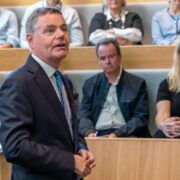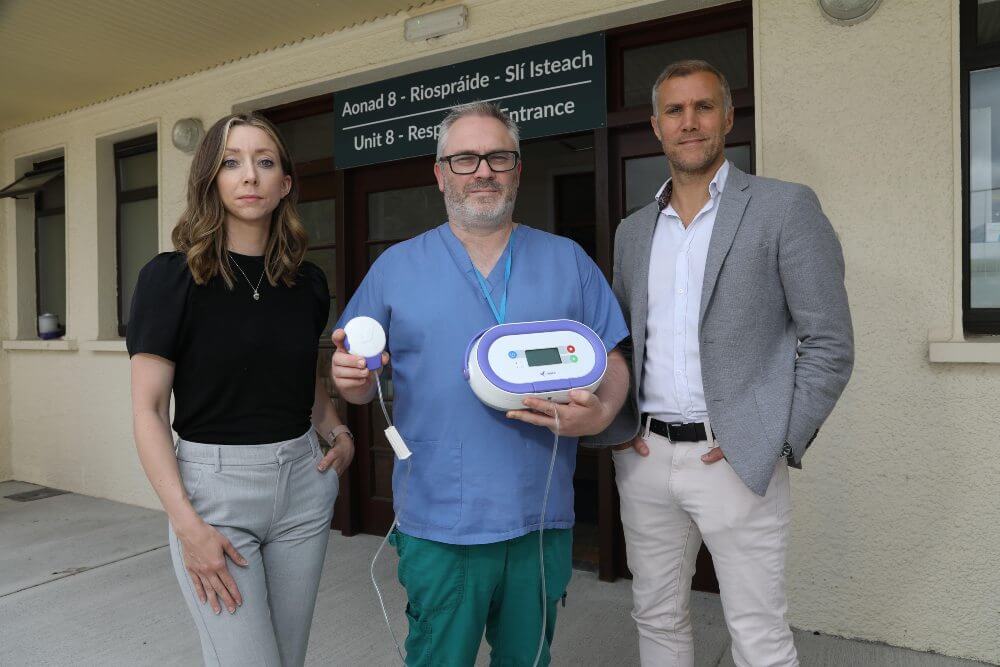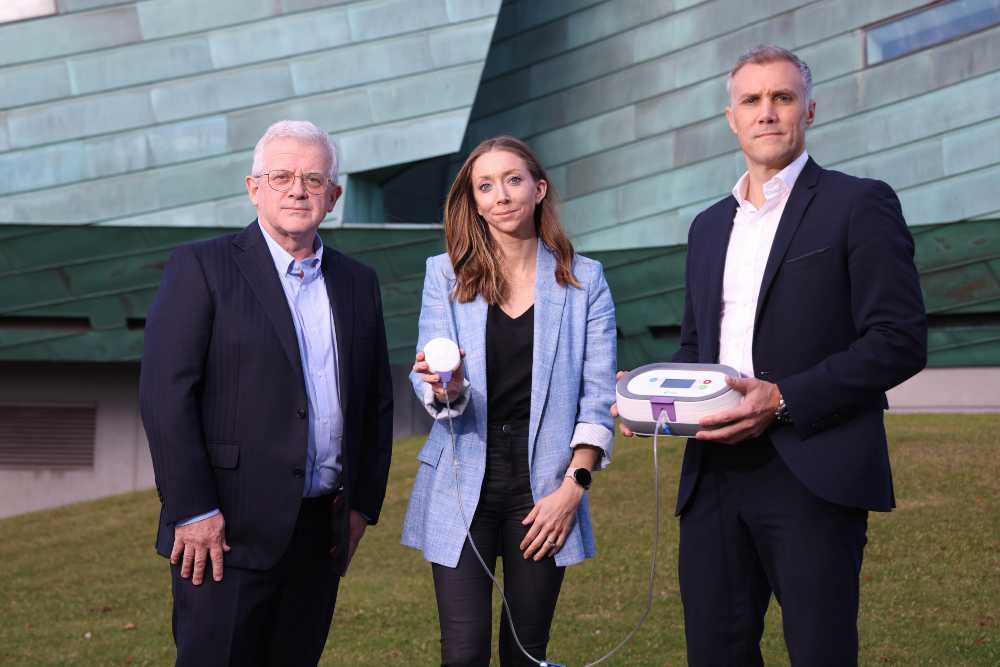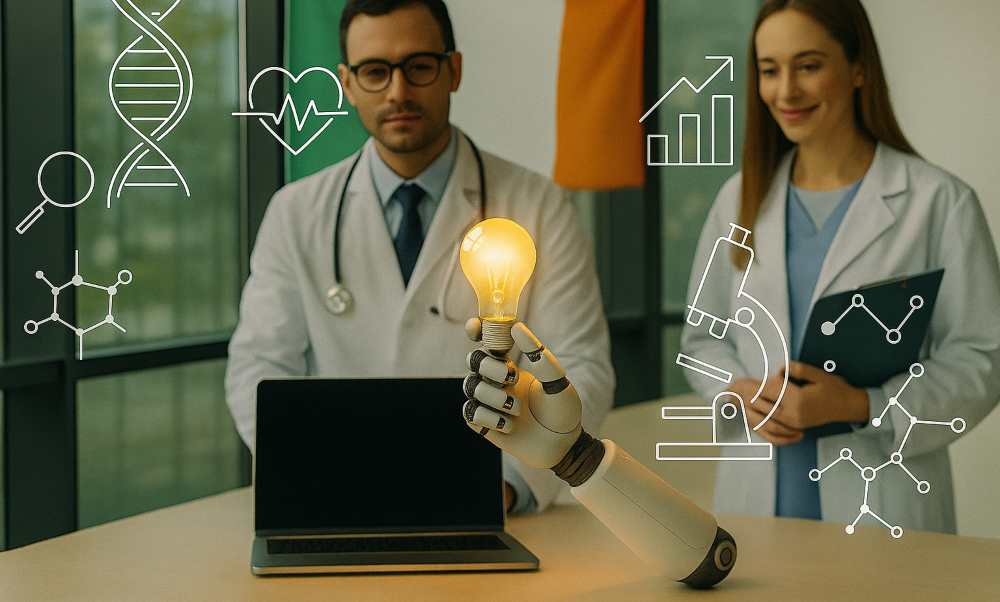Podcast Ep 281: How two Galway University researchers are revolutionising end-of-life care for cancer patients.
After meeting in the Bio Innovate programme at the University of Galway, Tim Jones and Dr Michelle Tierney embarked on a journey that today is seeing them target €40m in revenues via a US expansion.
Galway-based SymPhysis Medical is developing a patient-centric device called Releaze to treat malignant pleural effusion, a condition affecting around 50% of late-stage cancer patients. The device allows patients to manage fluid buildup in the chest at home, reducing hospital visits and improving quality of life.
“We try to have a consistent patient and carer voice in many aspects of what we do”
Their breakthrough device is timely as late stage cancer patients experience severe breathlessness, chest pain and anxiety as they can accumulate up to three litres of fluid. Alarmingly there has been no major innovation in this space in more than 25 years. And this is where Symphysis Medical comes in.
The company has raised over €5.6m to date, including €1.9m in 2022 and €1.5m in 2023. SymPhysis is targeting FDA approval and a US market launch, with ambitions to raise an additional €4.5m to support expansion and regulatory milestones.
Getting ready for Releaze
The Bio Innovate programme that they both took part in took people from multidisciplinary backgrounds and placed them in clinical setting where they could identify a problem that might be addressed through a medical or digital device.
Tierney said that the idea for Releaze was born from eight weeks of clinical immersion, including four weeks at the Mayo Clinic and four weeks in three different Irish hospitasl.
“Tim and I were put on the same team looking at respiratory areas and pulmonology in particular. And it was out of that where we ultimately identified the area that we wanted to address, which is known as malignant pleural effusion, or fluid on the chest. Beyond that, we applied for multiple funding avenues, largely grants initially and eventually moving on to equity investments.”
Jones explained that malignant pleural effusion affects around half of all late stage cancer patients, and it presents with significant breathlessness, chest pain and anxiety for these patients.
“When they’re at home, this fluid just builds up. It can be about two to three litres in some instances, instead of being a healthy person where you only have two to three teaspoons of fluid. So you can imagine that extra amount of fluid putting pressure on the lung, putting pressure on the diaphragm, and the breathing mechanism is massively interrupted.”
Releaze allows patients to go home and drain independently of having to be in a hospital.
“The real aim is to ensure that patients can spend as much time at home as possible and really give them true independence, comfort and quality of life as much as we can for this part of the disease that they’re experiencing. They really do deserve so much better than what is on offer right now.”
Tierney said the Releaze device is designed to let patients try to continue their lives as normal.
“We have those considerations, not just from a function and form point of view of the device and how it’s used, but also practical day-to-day things like: How is it stored? How does the device look on their kitchen table? Can they travel with it? From a sustainability perspective, are we considering how much plastic is going into this? When they go home, they do need to perform what is a sterile procedure. They do need to be mindful of their hygiene, where it’s performed, which is a burden in and of itself. But if we can design it such that it makes it easier to conduct that, then we’re helping.”
Both Jones and Tierney agree that spending time with the patients on both sides of the Atlantic to identify their needs was time well spent, even though poignantly the patients themselves may not live to experience the results.
“It struck us that if this a problem in both of these places, then it must be a real problem,” Tierney said. “The other thing was that we were so lucky to have those conversations with patients, because clinicians are very protective of their patients. They had to make sure that having those conversations wasn’t going to cause any upset or that we were going to be sensitive to the journey they were going through.
“Ultimately, most patients found those conversations very comforting to know that at least, if they weren’t going to benefit from a new device, the input they were going to give into a new device was going to address needs that maybe the existing technology doesn’t. So they were core to us ultimately coming up with this particular need and the design. We’ve continued to maintain that patient and carer voice as integral to how we develop our devices and future devices as well, because they have observations that the patients may not even have of themselves. We try to have a consistent patient and carer voice in many aspects of what we do to ensure that we are looking at all of the holistic aspects that go into treating these patients.”
A new chapter Galway’s medtech revolution
Galway has firmly established itself as a global hub for medtech innovation, with a thriving ecosystem of world-class companies and cutting-edge research. Home to over 100 medtech firms, the region boasts a strong concentration of talent and infrastructure that supports everything from R&D to advanced manufacturing. Notable players include Medtronic, which operates one of its largest global facilities in Galway, Boston Scientific, a key employer and innovator in cardiovascular devices, and Aerogen, a world leader in aerosol drug delivery systems. Indigenous success stories like Neurent Medical and Galway-based Tympany Medical further highlight the region’s strength in developing novel solutions.
I ask them what is it about Galway that makes it conducive to creating and building medtech start-ups and how they feel about being part of the next chapter.
Jones believes that it lies in programmes like Bio Innovate and the strong ethos of university-industry collaboration. The result is a robust start-up scene and a region that attracts investment and talent.
“The programme enables teams to actually have protected time to look for those unmet needs in a way that you wouldn’t have time if you were a multinational and you wouldn’t have time as a clinician. So there’s a gap in between, and that enabled that gap to be filled. Having 10 months protected time to ensure that you’re looking at true unmet or under-met needs has been a game changer for Galway specifically.
“If you look at the supports that have been built around that, it’s not just finding the unmet need, it’s having the support to enable you to grow. We have an incredible ecosystem in Galway where there’s support across startups, SMEs helping the startups, and the multinationals. My background is having been in the R&D environment in Medtronic, and after leaving there, I wouldn’t have had any idea how much support I would have got from Medtronic after that period of time. I see that across the entire ecosystem – whether it’s an individual or a multinational, the support is there to try and make us successful as a group, and to really drive medtech, not just in the west of Ireland, but to represent the entire island of Ireland as well.”
Tierney adds: “It’s also worth mentioning the universities here in Galway – University of Galway and Atlantic Technological University. Coming out of the Bio Innovate program, we would have been researchers at the University funded through Enterprise Ireland. That gave us the lab space and office space we needed to get the whole thing off the ground. We had huge support from the Innovation Office there in terms of IP and spinning out successfully.
“Now we benefit yearly from having students from both of those academic institutes come and do placements with us and add huge value. We’ve just had two students finish their placements, and we don’t know what we’re going to do without them, because they are so keen to learn. They get an insight as to what it’s like to be in a start-up environment and they get the bug. We’ve actually seen students who have had placements with us come back and are now employees with us. The academic, multinational and SME environment in Galway, plus just the location and the tight-knit community that’s in Galway anyway, all integrates into that whole aspect.”
Jones adds that Enterprise Ireland in particular has been instrumental in showing belief in early stage medtech and life sciences companies. “They help them prove out the technology initially and then support them as they grow through either grant investment or equity investment, mentorship, setting up programmes, whether it might be a founders forum or something like that. They’ve been instrumental in us getting to where we are today. You’ve got a really strong ecosystem that is really working to be quite symbiotic across all the sectors.”
In recent months it emerged that SymPhysis is strengthening its management team ahead of the US launch of Releaze. With clearance from the US Food and Drug Administration (FDA) targeted by 2026, SymPhysis Medical aims to launch its device within the next 18 months and to reach €40m in revenue by 2030.
The business is taking a US-first approach and according to Jones has hired its VP of Marketing and Sales 18 months ahead of target.
“That seems very early for a start-up, but the importance of understanding your commercial launch and growth phase now is more so than ever. A lot of companies might have been looking down the route of an acquisition model previously, some may still well be suitable for that. But in general, you need to prove that you can start selling in one geography, get repeat sales, build a sales team that can actually grow and scale an indigenous company. We believe we can through everything that we’ve built, not just on the commercial side in the US, but everything we’ve built around the company in Ireland as well.”
Despite the geopolitical tensions in the world and confusion caused by Trump’s tariff war, Jones said the most important thing that exporters can do is focus. “As long as we understand what our launch plan is and when that might affect us, which at this point in time is only going to be in two years in the future, how can we predict what the tariffs are going to be? We can keep on top of it and ensure that we bake those into our financial modelling, but we, like everybody else, can’t give any certainties of the effect that will have on the business.
“Like with every part of the business that we drive, we measure risk, we put mitigations into place, and we don’t knee-jerk react, but we take all the information in front of us on board, and we make the best decision we can at hand.”
-
Bank of Ireland is welcoming new customers every day – funding investments, working capital and expansions across multiple sectors. To learn more, click here
-
For support in challenging times, click here
-
Listen to the ThinkBusiness Podcast for business insights and inspiration. All episodes are here. You can also listen to the Podcast on:
-
Spotify
-
SoundCloud
-
Apple





